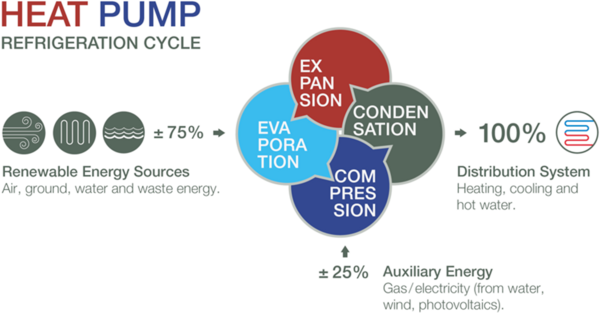The European 2020 package set binding targets to ensure that the EU will by 2020:
- Reduce its greenhouse gas emissions by 20 %
- Increase the use of renewable energy sources by 20 %
- Improve energy efficiency by 20 %
Heat pumps can play a considerable role in reaching those key objectives as they reduce final and primary energy demand, in particular demand of fossil sources, reduce greenhouse gas (GHG) emissions, and use renewable energy sources in form of latent energy from ground, water or air.
Heat pumps always provide heating and cooling, thus giving the same device an additional economic advantage in cases where both services are needed. In heating mode, heat pumps take stored solar heat from air, water, or ground and release it together with the input energy in the form of useable heat to the heating and hot water circuit. In cooling mode, refrigerators operate to extract heat from inside and discharge it to the outside. By moving rather than generating energy, they are environmentally friendly and extremely energy-efficient.
The 4 Main Characteristis of Heat Pumps
1. ENERGY EFFICIENCY
Heat Pump can demonstrate in the range of 120 % to 300 % efficiency. For each kW of electricity consumed, they generate about 4kW of thermal energy.
Comparison with other heating technologies:
- Condensing gas/oil boiler: 90 – 96 % efficiency
- Conventional gas/oil boiler: 70 – 80 % efficiency
- Direct electric heating: 35 – 45 % efficiency
2. SUSTAINABILITY
Heat Pumps contribute to an annual reduction of 9,16 million tons CO2 emissions in the EU. About 75 % of the energy that is used is renewable, whereas 25 % of the energy is generated by other sources (in 99 % this is electricity). If the electricity is generated by renewables (PV, wind, hydro), then the heat pump is 100 % renewable and CO2-neutral. According to IEA, heat pumps could save 50 % of the building sector’s CO2 emissions, and 5 % of the industrial sector’s. This means that 1.8 billion tonnes of CO2 per year could be saved by heat pumps.
3. EUROPEAN BACKGROUND
The vast majority of the heat pumps installed in Europe are also manufactured in Europe. In fact, the EU heat pump companies play a leadership role in the technology development (EHPA). They foster EU employment: 40 358 Europeans are full-time working in the heat pumps sector. This is a very moderate estimation based on the sales data in Europe, on which we applied a certain factor: man-hours needed to install the different types of heat pumps. (EHPA)
4. ENERGY SECURITY
The EU imports annually energy worth over 400 billion euro. Heat pumps reduce the use of primary and final energy. So we would need less energy and by consequence less would need to be imported. This saves costs and secures the supply of energy at the same time: we become more energy independent.
The Heat Pump Cycle
The operating principle of heat pumps is based on transferring heat energy by circulating a working fluid (refrigerant) through a continuous cycle of evaporation and condensation. The refrigerant cycle, called the Carnot cycle, includes four main stages:
- Evaporation
In a heat exchanger the liquid refrigerant absorbs energy from the heat source (water, soil or air) and turns into gas. - Compression
The refrigerant is put through a compressor run by auxiliary energy that causes the pressure of the gas to increase and its temperature to rise. The refrigerant leaves the compressor as a hot gas. - Liquefaction/condensation
The hot gas flows into the liquefier, releases energy to the heating system, falls in temperature and returns to a liquid state. This energy is used to create hot water for both central heating and domestic hot water supply. - Expansion
The hot, liquid refrigerant is transferred to the expansion valve. In the expansion valve the pressure is reduced very rapidly and thus the temperature of the refrigerant drops quickly without releasing energy. The refrigerant leaves the expansion valve as a cold liquid, ready to repeat the cycle again.
More details: https://keymark.eu/en/products/heatpumps/why-heat-pumps















